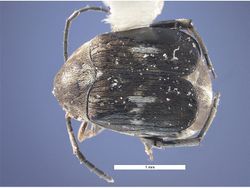Zabrotes subfasciatus
| Literature database |
|---|
| 70 articles sorted by: |
| • year (descending) |
| • research topics |
| • countries/regions |
| • host plants |
| • list of natural enemies |
Zabrotes subfasciatus (Boheman, 1833) - (Mexican bean weevil)
The beetle is a pest of stored legumes, especially Phaseolus beans, in tropical countries. It is also frequently introduced into temperate regions but requires higher temperatures to breed. It is believed to be native to Central America but now has a world-wide distribution, spreading with stored beans.
In the field it breeds inside bean seeds which have fallen to the ground or are still inside the dried pods. Stored beans contaminated with and attacked by the beetle are no longer marketable and are usually considered unfit for human consumption. Losses might reach 30%.
Control on a commercial scale usually involves fumigation or the application of diatomaceous earth. The development of botanicals like plant oils for protecting stored beans is in progress.
| Vernacular names | |
|---|---|
| • Deutsch: | Brasilbohnenkäfer |
| • English: | Mexican bean weevil |
| • Español: | gorgojo del Brasil |
| • Français: | bruche brésilienne |
| • Português: | caruncho-pequeno-do-feijão |
The adult is rather broad in shape and typically 2-2½ mm long with the female slightly larger. The colour is dark grey to black with a pattern of whitish scales. Each hind tibia has 2 moveable, reddish spurs at the tip. The hind femur lacks any teeth.
Synonyms:
Spermophagus subfasciatus
- Other images of Zabrotes subfasciatus (PaDIL - click to enlarge)



